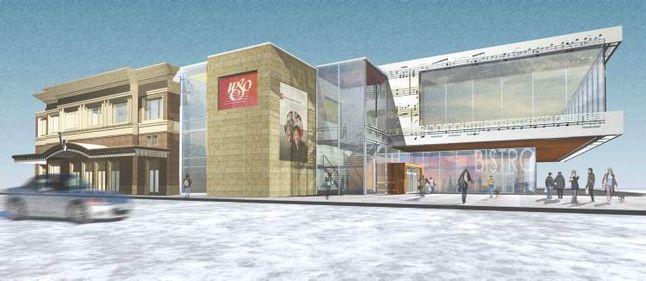
An artist's rendering of the 'new' WSO building.
As the sun broke over the horizon on a sleepy Monday morning in July of 1867, the people of British North America awoke as citizens of Canada. With thriving transportation and manufacturing industries, Montreal, at the head of the St. Lawrence River, would be the economic engine of the young Dominion, remaining the largest, most powerful city in the country for the next 100 years.
By the 1960s, Montreal had lost much of its lustre and influence, surpassed by Toronto as Canada's premier city. Development and population growth slowed as business migrated west and traditional industries lost prominence in the modern economy.
Montreal's story is familiar to the people of Winnipeg. Our city's own decline from the powerhouse of the West to a regional capital struggling to compete with our prosperous neighbours, closely parallels Montreal's fall from prominence. Despite (perhaps because of) these economic challenges, vibrant cultural and artistic communities have historically flourished in both cities.
Montreal has long been a pre-eminent city of art and culture in North America and Winnipeg's list of cultural institutions would be the envy of cities many times its size.
Over the past decade, cultural leaders in Montreal have come together to formalize the role of its creative industries as a fundamental vehicle in the city's development, improving its economic prosperity, international image and health and well-being of its citizens.
Strategic partnerships have been formed with government and industry to capitalize on this unique civic attribute and brand the city as a Cultural Metropolis. A series of planning summits has put cultural development at the top of the political and civic agenda through the establishment of a formal 10-year implementation plan called Montr©al, m©tropole culturelle. Funding for the arts is no longer seen as a cost to the community but an investment in it. The result has been an urban renaissance as new theatres, performance spaces and studios of the highest architectural quality have been constructed throughout the city, and underused heritage buildings have been transformed to support grassroots cultural activity and education. This development has galvanized Montreal's artistic identity and stimulated its economic recovery during the recent recession.
Like Montreal, Winnipeg has in the past struggled with its external public image. Montreal's experience in harnessing the strength of a city's creative industries to facilitate growth and transform its civic identity might serve as an inspiration for Winnipeg today.
The creative industries already play a significant role in Winnipeg's economy, directly employing more than 25,000 people, responsible for four per cent of the city's GDP. Winnipeg has the highest level of private charitable contributions to the arts in Canada, which translates government investment into a significant economic catalyst in the community. Every dollar of municipal funding provided to the arts in Winnipeg leverages $18.23 in funding from other sources.
Two small but significant projects in Winnipeg are currently undertaking capital campaigns in hopes of leveraging public investment into new facilities that would redefine key cultural organizations and enrich the city's artistic diversity and image.
The Winnipeg Art Gallery recently announced it has chosen California architect Michael Maltzan and Winnipeg firm Cibinel Architects to design its Inuit Art and Learning Centre. The new facility will celebrate the world's largest public collection of Inuit art and be a leading centre for the research of Inuit culture. The daunting architectural challenge will be to create a unique and signature expression for the new gallery while complimenting the Modernist lines of the iconic existing building.
The Winnipeg Symphony Orchestra has dreams of transforming the Pantages Playhouse Theatre into a first-class performing arts centre that harmonizes modern amenities with the inspiring atmosphere of a carefully restored historic theatre space. Working with Number Ten Architectural Group, their vision is a grand rehearsal hall cantilevered over the sidewalk creating a dramatic and playful announcement of their presence on Main Street. The building's transparency will break down traditional barriers between the symphony and its patrons, allowing rehearsal space to visibly engage the urban surroundings, opening to allow performances to the landscaped plaza below.
The facility will provide an opportunity for the WSO to increase its educational and community programming, expand its production capabilities and provide secondary revenue streams through leasable function space, retail areas and food services. (Disclosure: I am the lead architect on this project.)
A city's artistic and cultural community should of course not be viewed solely through the lens of economic influence, but understanding its value in stimulating growth can help inform public policy and investment strategy.
Several new, architecturally unique cultural buildings in Winnipeg have already begun to redefine the city's artistic image. The introduction of the Canadian Museum for Human Rights will fundamentally shift this cultural landscape. The scale and impact of a national museum in our community might be the impetus to follow Montreal's lead and bring together the city's artistic organizations, establishing a unified "creative community" brand that capitalizes on cultural-tourism opportunities and increases awareness of Winnipeg's creative industries.
Cultivating the creative economy in a city does not only mean supporting institutional projects like such as the WAG and WSO proposals. It also requires the establishment of public policy that stimulates community initiatives such as the construction of affordable artist live/work studio space, educational programing, music venues such as the Windsor and Royal Albert hotels and galleries such as Raw and Urban Shaman. By embracing our creative sector as a driver of the local economy, we might also redefine Winnipeg's image from a land of snow and mosquitoes to our own type of Cultural Metropolis.
Brent Bellamy is senior design architect for Number Ten Architectural Group.
bbellamy@numberten.com
Republished from the Winnipeg Free Press print edition May 21, 2013 B6